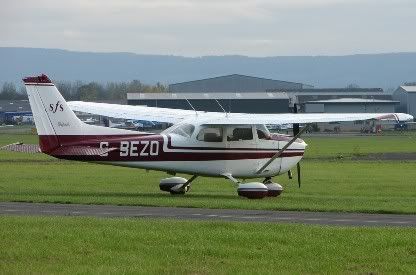The only slight fly in the ointment is that I have a grand total of 2.5 hours in any type of Cessna. I know and I agree that after a while and experience of a few different aircraft, that ‘a plane is a plane is a plane’, especially ubiquitous training aircraft like a C172 etc. However, I want to make sure I have some recent experience and am familiar with the ‘gotcha’ type differences that a C172 may hold before I appear for my checkride in Canada and make a twit of myself!
So I booked a one hour checkride at one of the local schools at Staverton that have an all-Cessna fleet. This was for an evening flight after work and I rolled up in plenty of time and got changed.
While waiting for the instructor, I admired the weather and the aircraft pottering around the airfield. Sunny and warm with only a modest breath of wind – wonderful! I even saw ‘my’ RV6 (OK, I have a share) line up on 22 and take off.
My instructor turned up and ushered me into the briefing room to find out what I was after. I explained I just wanted a bit of a workout on a Cessna 172. So we agreed on a few turns, then a few stalls in various configurations, a PFL and a few circuits with mixed landing types when we got back.
We drove over to the aircraft (the club is the other side of the airfield from the parking apron) and I popped out my commercially purchased C172 checklist and started working through it on a guided walkaround. I found the checklist illogical and annoying, as did my instructor. Still I carried on and Neil pointed out the specific things to check on a walkaround.

I have to say my personal favourite was checking the fuel in the gascolator. I have never seen anything like this before. Basically, you open the oil check door, locate a button with one hand, bend down and reach under the aircraft with the other hand holding the fuel drainer, press the button, see where the fuel is squirting out and try to hold the fuel drain under the flow to catch some fuel – long arms required!
I also particularly enjoyed testing the stall warner. Nothing can be seen or reached externally, so you have to wrap your mouth around the aperture in the wing and inhale sharply (note that I have resisted using the sexually suggestive words ‘hole’ and ‘suck’ respectively!). You are rewarded by a vague and faint rattle, a but like the sound you make blowing over a blade of grass held between your thumbs).
The fuel system is simple and easy, no electric pump (one of the benefits of a high wing design) and just stick it on ‘both’ and the fuel will feed from both tanks.
Walkaround complete, we climbed in as I started up. It fired up easily and first time and the engine sounded sweet. Taxy out to E1 for 22. Power checks are straightforward and simple enough. I line up and power up for take-off. This is no RV6 as we trundle down the runway. The airspeed slowly builds and the plane feels like it is running on rails it is so directionally stable compared to the RV. Eventually at 55, the plane starts to hop and at 60 I give it a gentle rotate and we are off. Trim for 75kts and the rate of climb is about 600 fpm – sedate and stable.
We head towards the Malverns as I climb to 1500’ and level out so I can see the level picture. I get this easily first time and we do a few turns. She is heavy in roll (OK, heavy in everything, but then most things are compared to the RV), but feels very stable.
We resume a climb to 3200’ to do a few stalls. The first is a stall recovery on first signs in normal flight configuration. The plane just gets a bit mushy, so I apply full power, nose down and recover. This was a pleasing 75’ altitude loss. The second is in landing configuration with full flaps and recover on his command. This was the same again really, the stall is a complete non-event as I power up, push forward and pull some flaps off, recover and clean up. Very well behaved in the stall.
Then we drop to 2000’ as he pulls the power for a PFL. I run through the drill and spot a remarkably runway like long and narrow ‘field’ roughly into wind, so I nominate that. ‘Yeah, it might work if you can avoid the jumps’ Neil announces. I don’t see any obstructions, but Neil knows that this is a ‘horse gallop’ for the local stables. Sure enough, closer in, there are jumps to one side, but the right hand side is clear and plenty wide enough for the Cessna. I run through the checks, radio and shut down drill. The Cessna just seems to float and glide forever and is in no hurry to loose altitude. I extend my base then turn final. Still way high, so full flaps. I know that you can’t sideslip with full flaps in the C172, something to do with the wings blanking the airflow over the elevators leading to loss of control, crash and death, so I can’t do that! On short-ish final, still high, I throw the plane around in some steep ‘s-turns’ which helps to lose height. Short final now and much better, probably no more that 200 feet now and it seems clear to me that we will ‘get in’. He give me the go-around.
Back to the airfield at a leisurely 90kts as I call for rejoin. Standard overhead join for 22 and I ask for and am given circuits.
The overhead join goes well as I come in for a normal landing. I line up on the centreline pulling on flaps and stablising the approach to 60 – 65. I am high, so full flaps. Still high and Neil advises to pull to power completely on short final. So I do as we come in for a glide landing. Not one of my better landings as I misjudge the heaviness of the controls and pull back too much and balloon a bit. But I hold off the second time for a not-terribly-graceful landing. Power up, flaps up and off again.
Second approach is with Neil’s preferred 20 degrees of flaps only. This is better and I find this a lot easier. The Cessna is very floaty.
Third and final approach is for a flapless. The approach is faster and much ‘flatter’ as I come in at 70. Neil advises me to be very careful over airspeed as the plane could just float all the way down the long 1000m runway! I get the speed right and hold off pretty well though I say it myself. While I was training, I always enjoyed flapless landings best of all, somehow I found them the easiest of the lot. This is my best landing of the three, I think I am getting used to the relative ‘heaviness’ of the plane now.
We taxy back and shutdown. Neil is keen to get off home as he has logged five hour today and is pretty tired.
Well a surprisingly useful lesson. I have picked up on a lot of the ‘oddities’ of the C172 and re-familiarised myself with the forgiving and relatively heavy controls and easy but ponderous landing characteristics of the plane. This I am certain, will serve me well when I do the checkride in Canada – I just hope it hasn’t screwed me up for handling in the RV6!
